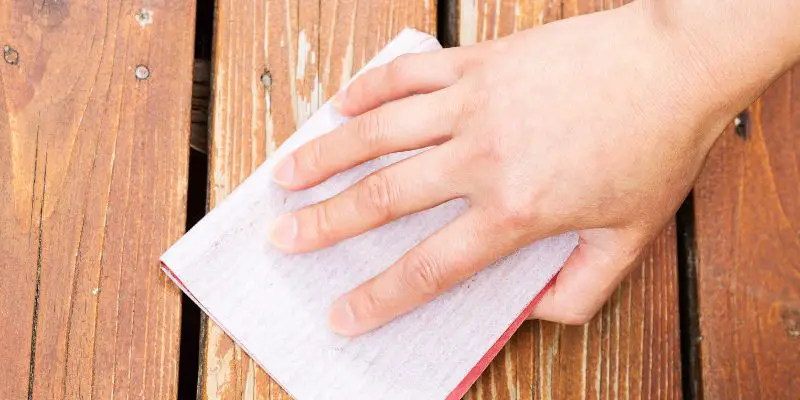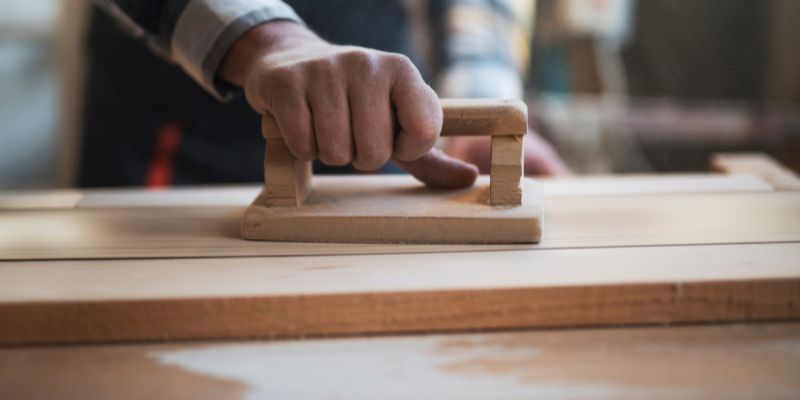To sand wood, begin with coarse grit sandpaper to remove imperfections, then progress to finer grit for a smooth finish. Sand in the direction of the wood grain, and ensure to remove all previous finishes and blemishes before applying a new one.
Sanding wood is an essential step in preparing it for staining, painting, or finishing. It involves using abrasive materials to smooth the surface and remove imperfections. Proper sanding enhances the wood’s aesthetic appeal and ensures a professional-looking result. There are various techniques and tools available to sand wood effectively.
By understanding the process and using the right equipment, you can achieve a smooth and flawless surface for your woodworking projects. We will explore the best practices and step-by-step instructions for sanding wood to help you accomplish high-quality results.
Types Of Sandpaper And Uses
When it comes to sanding wood, understanding the different types of sandpaper and their uses is crucial for achieving a smooth and refined finish. From explaining grit sizes and their effects to matching sandpaper types to specific wood species and comparing ceramic, aluminum oxide, and silicon carbide, this guide will help you navigate the diverse world of sandpaper.

Explaining Grit Sizes And Their Effects
Grit sizes are crucial to achieving the desired finish on your wood. The higher the grit number, the finer the sandpaper and the smoother the finish it creates. Here is a breakdown of common grit sizes:
| Grit Size | Uses |
|---|---|
| Coarse (40-60) | Rapid stock removal, shaping, and leveling uneven surfaces |
| Medium (80-120) | Smoothing and initial finishing |
| Fine (150-180) | Final finishing and preparing wood for staining or painting |
| Very Fine (220+) | Buffing and polishing for a glass-like finish |
Matching Sandpaper Type To Wood Species
When sanding different wood species, it’s important to use the right type of sandpaper to prevent damage and achieve the best results. Here’s a quick guide to matching sandpaper to wood types:
- Softwood (Pine, Cedar) – Medium to fine grit sandpaper
- Hardwood (Oak, Maple) – Fine to very fine grit sandpaper
- Exotic wood (Mahogany, Teak) – Very fine grit sandpaper
- Painted wood – Coarse grit sandpaper for paint removal, followed by a finer grit for smooth finish
Ceramic Vs. Aluminum Oxide Vs. Silicon Carbide
Understanding the differences between the material composition of sandpaper is essential for choosing the right type for your project:
- Ceramic – Offers superior durability, ideal for heavy-duty sanding and aggressive material removal
- Aluminum Oxide – Versatile and durable, suitable for general purpose sanding and finishing
- Silicon Carbide – Ideal for wet sanding and working on non-ferrous metals
Sanding Techniques For Beginners
Sanding wood is an essential skill for anyone who enjoys woodworking or DIY projects. Proper sanding techniques can make a significant difference in the final look and feel of your wood projects. Whether you are new to woodworking or looking to refine your skills, mastering the art of sanding can greatly improve the quality of your work. This section covers some fundamental sanding techniques designed specifically for beginners.
Hand Sanding Versus Power Sanding
When it comes to sanding wood, beginner woodworkers often wonder whether to use hand sanding or power sanding tools. Each method has its advantages and drawbacks.
Hand sanding gives you more control over the pressure and direction, making it suitable for delicate or intricate areas of the wood. On the other hand, power sanding is more efficient for larger projects and can save time and effort.
Direction Of Grain And Sanding Motion
Understanding the direction of the wood grain is crucial for a successful sanding process. Sanding against the grain can cause splintering and a rough finish, while sanding with the grain produces a smoother surface. It’s important to always sand with the grain, using long, even strokes for an uniform finish.
Pressure Control And Avoiding Over-sanding
Applying the right amount of pressure is essential for achieving a smooth and even surface. Avoiding over-sanding is equally important, as it can lead to uneven surfaces or even wood damage. Use light to moderate pressure, and regularly check the progress to prevent over-sanding.
It is advisable to use tables, bullet points, ordered lists, and images in this section. For example, to illustrate the different types of sandpaper grits or the appropriate pressure levels, a table or an image can be used. Additionally, including tips and tricks for controlling the pressure and avoiding over-sanding will add value to this section.
Setting Up Your Sanding Workspace
Setting up your sanding workspace is crucial to ensure a smooth and efficient wood sanding process. A well-organized and safe environment not only enhances the quality of your work but also minimizes the risk of accidents and health hazards. In this section, we will discuss the essential elements of a properly set up sanding workspace, including ventilation and dust collection, lighting and workbench setup, and safety gear.
Ventilation And Dust Collection
Proper ventilation and dust collection are essential for a safe and healthy sanding workspace. Wood dust and particles can pose respiratory and health risks if inhaled over a prolonged period. To ensure effective ventilation and dust collection, consider the following:
- Position your sanding workstation near a window or use a fan to maintain air circulation.
- Incorporate a dust collection system or a shop vacuum to capture airborne particles.
- Wear a dust mask or respirator to protect your respiratory system from fine wood particles.
Lighting And Workbench Setup
Good lighting and a well-organized workbench are essential for precision and safety during the sanding process. Consider the following when setting up your workspace:
- Ensure ample lighting to clearly see the wood surface and any imperfections.
- Position your workbench at a comfortable height to reduce strain on your back and shoulders.
- Keep your work area clutter-free to minimize the risk of accidents and to have easy access to your tools and supplies.
Safety Gear: Masks, Goggles, Gloves
Protective gear is a non-negotiable aspect of any woodworking workspace. Ensure you have the following safety gear at your disposal:
| Item | Usage |
|---|---|
| Dust mask or respirator | To protect your respiratory system from airborne wood particles. |
| Safety goggles | To shield your eyes from flying wood particles and debris. |
| Gloves | To safeguard your hands from splinters, sharp edges, and abrasive materials. |
Selecting The Right Grit Sequence
When sanding wood, selecting the right grit sequence is crucial for achieving a smooth and professional finish. The grit sequence refers to the progression of sandpaper grits used to remove imperfections and achieve the desired level of smoothness. Starting with the right grit and progressing through finer grits plays a significant role in enhancing the quality of the final result.

Starting With The Right Grit
Selecting the correct starting grit for your sanding project is essential. The initial sandpaper used should be of a coarse grit, such as 60 or 80. This grit is effective for removing rough imperfections and leveling the surface. Coarse grits are ideal for initial sanding or when significant material removal is necessary.
Progression Through Finer Grits
After starting with a coarse grit, it’s important to progress through finer grits to achieve a smoother finish. Once the rough imperfections have been removed, switch to a medium-grit sandpaper, typically in the range of 100 to 150. This will further smooth the surface and prepare it for the next stage. Finally, finish the sanding process with a fine-grit sandpaper, such as 220 or higher, to achieve a remarkably smooth surface ready for staining or finishing.
When To Switch Sandpapers
Knowing when to switch sandpapers is essential to ensure an efficient and effective sanding process. As a general rule, transition to a finer grit once the previous grit has removed the imperfections and scratches from the surface. Regularly inspect the wood to determine when it is time to progress to the next grit. It is important to note that using the correct grit sequence can significantly impact the final outcome of your woodworking project.
Sanding Details And Curves
When it comes to woodworking, sanding details and curves is a crucial step to achieving a smooth and professional finish. Whether you’re sanding edges, corners, tough spots, or intricate moldings, using the right tools and techniques is essential. Let’s dive into the specifics of sanding details and curves.
Sanding Edges, Corners, And Tough Spots
Sanding the edges, corners, and tough spots of wood requires precision and care. To effectively reach these areas, consider using sanding blocks with angled edges or specialized edge sanding tools. Pay attention to the grain direction and use finer grit sandpaper gradually to avoid over-sanding and maintaining the wood’s integrity.
Tools For Detailed Sanding Jobs
For detailed sanding jobs, having the right tools can make all the difference. Opt for small hand sanders, such as detail sanders or oscillating multi-tools, to reach concealed areas and intricate crevices. Additionally, investing in high-quality sandpaper with various grits is vital for achieving a professional and smooth finish.
Sanding Profiles And Moldings Effectively
Effectively sanding profiles and moldings requires attention to detail and the right approach. Utilize profile sanders or custom-made sanding blocks to match the curves and contours of the woodwork. This ensures uniform sanding and maintenance of the wood’s original shape. Always sand with the grain direction to prevent unnecessary damage.
Final Sanding And Surface Preparation
Once you have completed the bulk of the sanding process, it’s time to focus on final sanding and surface preparation techniques to achieve a smooth and polished finish for your wood project.
Tack Cloth For Dust Removal
Using a tack cloth is an effective method for removing any remaining dust particles that may have settled on the wood surface. Gently wipe the tack cloth across the wood, ensuring all dust is lifted away without leaving any residue behind.
Raising The Grain With Water
After final sanding, lightly dampen the wood surface. This will cause the wood fibers to swell, making it easier to identify any raised grains. Once the wood is dry, lightly sand it one more time to smooth out any raised fibers, creating a flawless surface for finishing.
Final Inspection Before Finishing
Before proceeding with the finishing process, it’s crucial to conduct a thorough final inspection of the wood. Inspect the surface from all angles, ensuring there are no imperfections or raised grain remaining. Address any issues before applying the finishing product to achieve a professional and polished outcome.
Frequently Asked Questions For How To Sand Wood
What Is The Golden Rule Of Sanding?
The golden rule of sanding is to start with coarse sandpaper and progressively move to finer grits for a smooth finish. It’s important to sand with the grain and avoid applying too much pressure, as well as to remove dust between sanding stages for best results.
What Do You Start Sanding Wood With?
Start sanding wood with coarse-grit sandpaper to remove imperfections and level the surface. 80-100 grit is suitable for initial sanding.
How Do You Sand Unfinished Wood?
To sand unfinished wood, start with coarse sandpaper and gradually move to finer grits. Sand in the direction of the grain. Remove dust with a tack cloth. Finish with a wood conditioner before staining or painting. Wear a dust mask and goggles.
What Is The Best Sandpaper To Use On Wood?
The best sandpaper for wood is usually between 80-120 grit for initial sanding and 180-220 grit for finishing. It’s important to match the sandpaper grit to the wood’s hardness for best results. Always start with the coarser grit and finish with a finer one for a smooth finish.
Conclusion
Mastering the art of sanding wood is essential for achieving a professional-looking finish on your projects. By following the proper techniques and using the right tools, you can create smooth and polished surfaces that enhance the beauty of the wood.
With practice and patience, you can elevate the quality of your woodworking projects and enjoy the satisfaction of a job well done.



2 thoughts on “How to Sand Wood: Expert Tips for Perfect Finish”